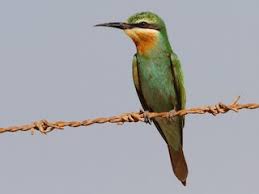Blue-cheeked Bee-eater:

The first breeding site of the Blue-Cheeked Bee-eater (Merops persicus) in peninsular India has been discovered in the saltpans of Aandivilai near the Manakudy Mangroves in Kanniyakumari district.
- It is a near passerine bird in the bee-eater family, Meropidae.
- It was historically known as passage migrant and winter visitor in India.
- It may choose to nest solitarily or in small, loose colonies of up to ten individuals. It is also known to share colonies with European bee-eaters.
- Its breeding was primarily recorded in regions such as Nile Delta, Pakistan and Iran while its wintering grounds include parts of Africa.
- This bird favors sub-tropical semi-desert regions dotted with sparse trees, such as acacias, for breeding.
- In its breeding grounds, this species occupies semi-desert, steppe, dunes, saline pans, cultivation, thorn woodland and sandy slopes with small gulleys, ravines, quarries, pits and embankments.
- It breeds mainly in sand deserts near bodies of water fringed with reeds and tamarisks.
- During the non-breeding season, it inhabits a wide variety of greener habitats including savanna, broad river valleys, woods, lakeshores, swamps, ponds, dams, waterworks and cultivation.
- Conservation status: IUCN: Least Concern




